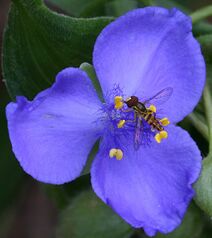Tradescantia virginiana
| Tradescantia virginiana | |
 | |
| Light: | |
| Moisture: | |
| Hardiness: | 7 |
| Soil pH: | 5.6-8.4 |
| Cross Pollinated | |
| Height: | 1' |
| Blooms: | Early Summer-Mid Fall |
| Open Woods Forest | |
| Native to: | |
| Nectary | |
| Edible Rating: | |
| Medicinal Rating: | |
| Tea: | Yes |
Tradescantia virginiana (common name: spiderwort)
Propagation: Seed - sow spring in a cold frame. When they are large enough to handle, prick the seedlings out into individual pots and grow them on in the greenhouse for their first winter. Plant them out into their permanent positions in late spring or early summer, after the last expected frosts.
Division in spring or autumn[1].
Cuttings of young shoots, July in a frame. They root easily and quickly.
Cultivation: An easily grown plant[2], it thrives in any good rather moist soil[3][1]. Succeeds in dry soils[4]. Succeeds in dappled woodland shade[5][1] or in full sun[1].
Hybridizes freely with other members of this genus[3]. Plants often self-sow in British gardens[3].
A very variable species, there are a number of named forms selected for their ornamental value[3].
Plants in this genus seem to be immune to the predations of rabbits[2].
Plants are self-sterile, at least two genetically distinct plants (and not divisions from the same plant) must be grown if seed is required.
Range: Eastern N. America - Connecticut to Wisconsin, south to Georgia and Tennessee.
Habitat: Woods, scrub, meadows and roadsides[6][7].
Edibility: Leaves - raw or cooked[8][9][10][11][12]. The very young shoots and leaves can be chopped and added to salads or cooked as a potherb[13].
Flowers - raw. They make an attractive edible garnish[13].
Medicinal: The roots are laxative[14]. They are also used as a tea in the treatment of kidney and stomach ailments and women's complaints[14][12].
A poultice of the leaves is applied to stings, insect bites and cancers[14][12].
Soil: Can grow in light, medium, and heavy soils.
Seed Ripens: Late Summer-Mid Fall
Flower Type: Hermaphrodite
Also Known As: T. virginica.
Links
References
- ↑ 1.0 1.1 1.2 1.3 Sanders, Thomas. Popular Hardy Perennials. Collingridge, 1926.
- ↑ 2.0 2.1 Thomas, Graham. Perennial Garden Plants. J. M. Dent & Sons, 1990.
- ↑ 3.0 3.1 3.2 3.3 Chittendon, Fred. RHS Dictionary of Plants. Oxford University Press, 1951.
- ↑ Brickell, Christopher. The RHS Gardener's Encyclopedia of Plants and Flowers. Dorling Kindersley Publishers, 1990.
- ↑ RHS. The Garden Volume 112. Royal Horticultural Society, 1987.
- ↑ Lyndon, Merritt. Gray's Manual of Botany. American Book Co, 1950.
- ↑ Phillips, Roger and Martyn Rix. Perennials - The Definitve Reference. Pan Books, 1991.
- ↑ Usher, George. A Dictionary of Plants Used by Man. Constable, 1974.
- ↑ Heywood, Vernon. Flowering Plants of the World. Oxford University Press.
- ↑ Tanaka, Tyōzaburō. Tanaka's Cyclopaedia of Edible Plants of the World. Keigaku Publishing, 1976.
- ↑ Weiner, Michael. Earth Medicine, Earth Food. Ballantine Books, 1980.
- ↑ 12.0 12.1 12.2 Moerman, Daniel. Native American Ethnobotany. Timber Press, 1998.
- ↑ 13.0 13.1 Facciola, Stephen. Cornucopia - A Source Book of Edible Plants. Kampong Publications, 1990.
- ↑ 14.0 14.1 14.2 Foster, Steven and Billy Tatum. Medicinal Plants of Eastern and Central North America. Houghton Mifflin, 1990.